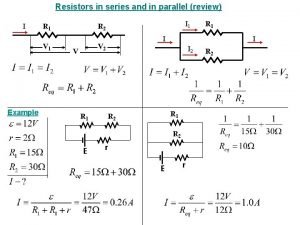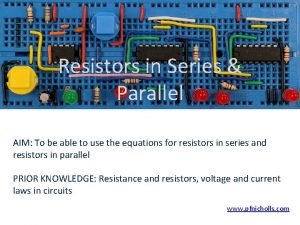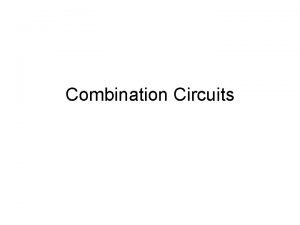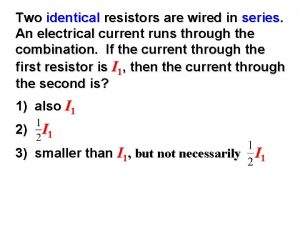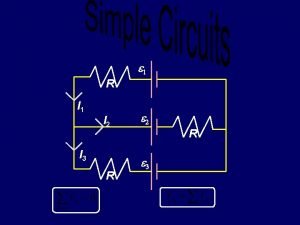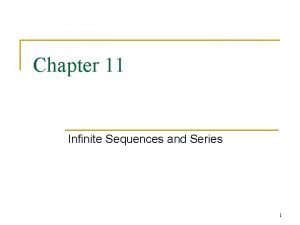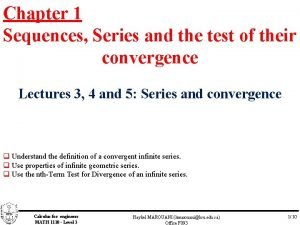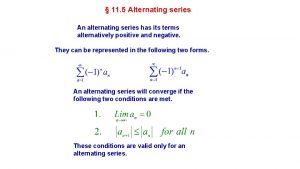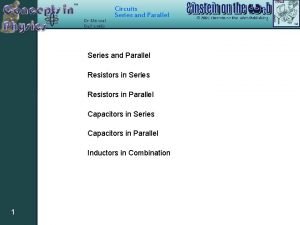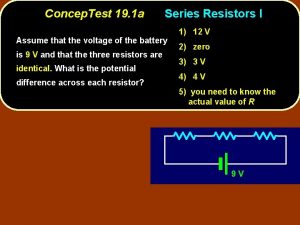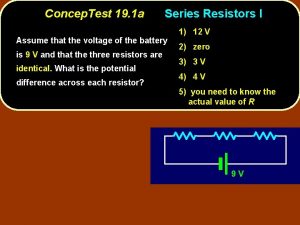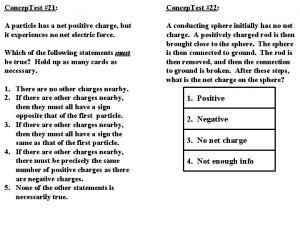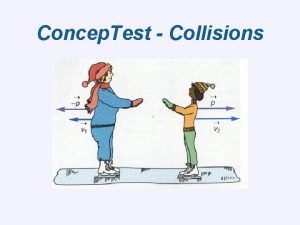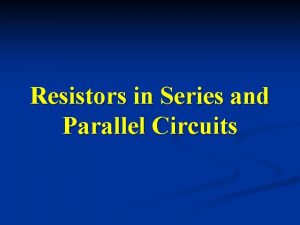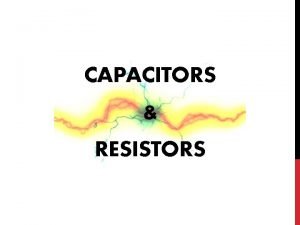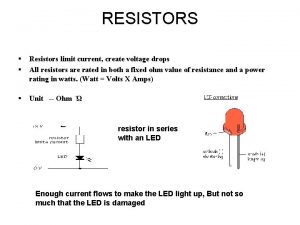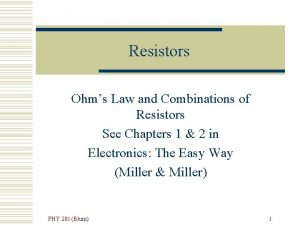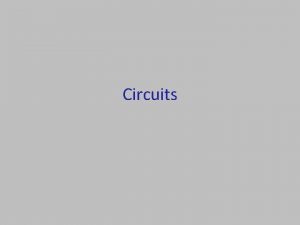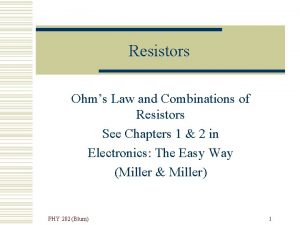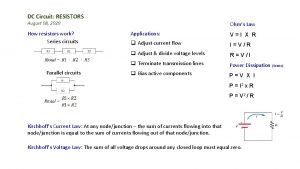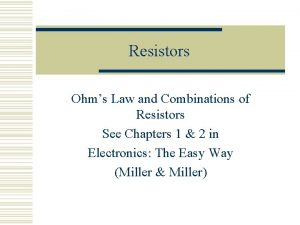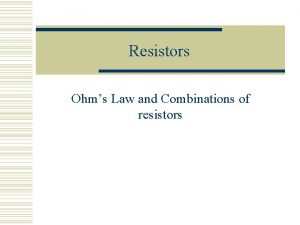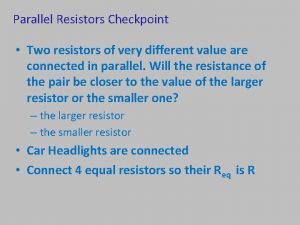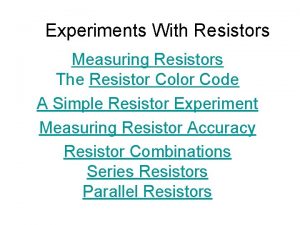Concep Test 18 1 a Series Resistors I






























- Slides: 30

Concep. Test 18. 1 a Series Resistors I Assume that the voltage of the battery is 9 V and that the three resistors are identical. What is the potential difference across each resistor? 1) 12 V 2) zero 3) 3 V 4) 4 V 5) you need to know the actual value of R 9 V

Concep. Test 18. 1 a Series Resistors I Assume that the voltage of the battery is 9 V and that the three resistors are identical. What is the potential difference across each resistor? 1) 12 V 2) zero 3) 3 V 4) 4 V 5) you need to know the actual value of R Since the resistors are all equal, equal the voltage will drop evenly across the 3 resistors, with 1/3 of 9 V across each one. So we get a 3 V drop across each. 9 V Follow-up: What would be the potential difference if R= 1 , 2 , 3 ?

Concep. Test 18. 1 b Series Resistors II 1) 12 V In the circuit below, what is the 2) zero voltage across R 1? 3) 6 V 4) 8 V 5) 4 V R 1= 4 R 2= 2 12 V

Concep. Test 18. 1 b Series Resistors II 1) 12 V In the circuit below, what is the 2) zero voltage across R 1? 3) 6 V 4) 8 V 5) 4 V The voltage drop across R 1 has to be twice as big as the drop across R 2. This means that V 1 = R 1= 4 R 2= 2 8 V and V 2 = 4 V. Or else you could find the current I = V/R = (12 V)/(6 ) = 2 A, then use 12 V Ohm’s Law to get voltages. Follow-up: What happens if the voltage is doubled?

Concep. Test 18. 2 a Parallel Resistors I 1) 10 A In the circuit below, what is the 2) zero current through R 1? 3) 5 A 4) 2 A 5) 7 A R 2= 2 R 1= 5 10 V

Concep. Test 18. 2 a Parallel Resistors I 1) 10 A In the circuit below, what is the 2) zero current through R 1? 3) 5 A 4) 2 A 5) 7 A The voltage is the same (10 V) across each R 2= 2 resistor because they are in parallel. Thus, we can use Ohm’s Law, V 1 = I 1 R 1 to find the R 1= 5 current I 1 = 2 A. A 10 V Follow-up: What is the total current through the battery?

Concep. Test 18. 2 b Points P and Q are connected to a Parallel Resistors II 1) increases battery of fixed voltage. As more 2) remains the same resistors R are added to the parallel 3) decreases circuit, what happens to the total 4) drops to zero current in the circuit?

Concep. Test 18. 2 b Parallel Resistors II Points P and Q are connected to a 1) increases battery of fixed voltage. As more 2) remains the same resistors R are added to the parallel 3) decreases circuit, what happens to the total 4) drops to zero current in the circuit? As we add parallel resistors, the overall resistance of the circuit drops Since V = IR, and V is held constant by the battery, when resistance decreases, decreases the current must increase Follow-up: What happens to the current through each resistor?

Concep. Test 18. 3 a Current flows through a Short Circuit I 1) all the current continues to flow through the bulb connected across the 2) half the current flows through the wire, the other half continues through the bulb, what happens? 3) all the current flows through the wire lightbulb. If a wire is now 4) none of the above

Concep. Test 18. 3 a Current flows through a Short Circuit I 1) all the current continues to flow through the bulb connected across the 2) half the current flows through the wire, the other half continues through the bulb, what happens? 3) all the current flows through the wire lightbulb. If a wire is now 4) none of the above The current divides based on the ratio of the resistances. If one of the resistances is zero, zero then ALL of the current will flow through that path. Follow-up: Doesn’t the wire have SOME resistance?

Concep. Test 18. 3 b Two lightbulbs A and B are connected in series to a constant voltage source. When a wire is connected across B, bulb A will: Short Circuit II 1) glow brighter than before 2) glow just the same as before 3) glow dimmer than before 4) go out completely 5) explode

Concep. Test 18. 3 b Two lightbulbs A and B are connected in series to a constant voltage source. When a wire is connected across B, bulb A will: Short Circuit II 1) glow brighter than before 2) glow just the same as before 3) glow dimmer than before 4) go out completely 5) explode Since bulb B is bypassed by the wire, the total resistance of the circuit decreases This means that the current through bulb A increases Follow-up: What happens to bulb B?

Concep. Test 18. 4 a Circuits I The lightbulbs in the circuit below 1) circuit 1 are identical with the same 2) circuit 2 resistance R. Which circuit produces more light? (brightness power) 3) both the same 4) it depends on R

Concep. Test 18. 4 a Circuits I The lightbulbs in the circuit below 1) circuit 1 are identical with the same 2) circuit 2 resistance R. Which circuit produces more light? (brightness power) In #1, the bulbs are in parallel, parallel lowering the total resistance of the circuit. Thus, circuit #1 will draw a higher current, current which leads to more light, because P = I V. V 3) both the same 4) it depends on R

Concep. Test 18. 4 b The three lightbulbs in the circuit all have Circuits II 1) twice as much the same resistance of 1 . By how 2) the same much is the brightness of bulb B greater 3) 1/2 as much or smaller than the brightness of bulb A? (brightness power) 4) 1/4 as much 5) 4 times as much A C B 10 V

Concep. Test 18. 4 b The three lightbulbs in the circuit all have Circuits II 1) twice as much the same resistance of 1 . By how 2) the same much is the brightness of bulb B greater 3) 1/2 as much or smaller than the brightness of bulb A? (brightness power) 4) 1/4 as much 5) 4 times as much A We can use P = V 2/R to compare the power: C B PA = (V ( A)2/RA = (10 V) 2/1 = 100 W PB = (V ( B)2/RB = (5 V) 2/1 = 25 W Follow-up: What is the total current in the circuit? 10 V

Concep. Test 18. 5 a More Circuits I What happens to the voltage 1) increase across the resistor R 1 when the 2) decrease switch is closed? The voltage will: 3) stay the same R 1 S V R 3 R 2

Concep. Test 18. 5 a More Circuits I What happens to the voltage 1) increase across the resistor R 1 when the 2) decrease switch is closed? The voltage will: 3) stay the same R 1 With the switch closed, the addition of R 2 to R 3 decreases the equivalent resistance, resistance so the current from the battery increases This will cause an S V increase in the voltage across R 1. Follow-up: What happens to the current through R 3? R 3 R 2

Concep. Test 18. 5 b More Circuits II 1) increases What happens to the voltage across the resistor R 4 when the 2) decreases switch is closed? 3) stays the same R 1 S V R 3 R 2 R 4

Concep. Test 18. 5 b More Circuits II 1) increases What happens to the voltage across the resistor R 4 when the 2) decreases switch is closed? 3) stays the same We just saw that closing the switch causes an increase in the voltage across R 1 (which is VAB). The voltage of the battery is constant, constant so if VAB increases, increases then VBC must decrease! decrease A R 1 B S V R 3 R 2 C Follow-up: What happens to the current through R 4? R 4

Concep. Test 18. 6 Even More Circuits 1) R 1 Which resistor has the 2) both R 1 and R 2 equally greatest current going through it? Assume that all 3) R 3 and R 4 the resistors are equal. 4) R 5 5) all the same R 1 V R 2 R 4 R 3 R 5

Concep. Test 18. 6 Even More Circuits 1) R 1 Which resistor has the 2) both R 1 and R 2 equally greatest current going through it? Assume that all 3) R 3 and R 4 the resistors are equal. 4) R 5 5) all the same The same current must flow through left and right combinations of resistors. On the LEFT, the current splits equally, so I 1 = I 2. On the RIGHT, more current will go through R 5 than R 3 + R 4 since the branch containing R 5 has less resistance R 1 V R 2 R 4 R 3 R 5 Follow-up: Which one has the smallest voltage drop?

Concep. Test 18. 7 Junction Rule 1) 2 A What is the current in branch P? 2) 3 A 3) 5 A 4) 6 A 5) 10 A 5 A P 8 A 2 A

Concep. Test 18. 7 Junction Rule 1) 2 A 2) 3 A What is the current in branch P? 3) 5 A 4) 6 A 5) 10 A The current entering the junction in red is 8 A, so the current leaving must also be 8 A. One exiting branch has 2 A, A so the other branch (at P) must have 6 A. A S 5 A P 8 A junction 2 A 6 A

Concep. Test 18. 7 Kirchhoff’s Rules The lightbulbs in the 1) both bulbs go out circuit are identical. When 2) intensity of both bulbs increases the switch is closed, what 3) intensity of both bulbs decreases happens? 4) A gets brighter and B gets dimmer 5) nothing changes

Concep. Test 18. 8 Kirchhoff’s Rules The lightbulbs in the 1) both bulbs go out circuit are identical. When 2) intensity of both bulbs increases the switch is closed, what 3) intensity of both bulbs decreases happens? 4) A gets brighter and B gets dimmer 5) nothing changes When the switch is open, the point between the bulbs is at 12 V. V But so is the point between the batteries If there is no potential difference, then no current will flow once the switch is closed!! Thus, nothing changes. Follow-up: What happens if the bottom battery is replaced by a 24 -V battery? 24 V

Concep. Test 18. 9 Wheatstone Bridge An ammeter A is connected 1) I between points a and b in the 2) I/2 circuit below, in which the four 3) I/3 resistors are identical. The current 4) I/4 through the ammeter is: 5) zero a b V I

Concep. Test 18. 9 Wheatstone Bridge An ammeter A is connected 1) I between points a and b in the 2) I/2 circuit below, in which the four 3) I/3 resistors are identical. The current 4) I/4 through the ammeter is: 5) zero Since all resistors are identical, identical a the voltage drops are the same across the upper branch and the lower branch. Thus, the potentials at points a and b are b also the same Therefore, no current flows. V I

Concep. Test 18. 10 More Kirchhoff’s Rules 1) 2 – I 1 – 2 I 2 = 0 Which of the equations is valid 2) 2 – 2 I 1 – 2 I 2 – 4 I 3 = 0 for the circuit below? 3) 2 – I 1 – 4 – 2 I 2 = 0 4) I 3 – 4 – 2 I 2 + 6 = 0 5) 2 – I 1 – 3 I 3 – 6 = 0 1 I 2 2 6 V 22 VV 4 V I 1 1 I 3 3

Concep. Test 18. 10 More Kirchhoff’s Rules 1) 2 – I 1 – 2 I 2 = 0 Which of the equations is valid 2) 2 – 2 I 1 – 2 I 2 – 4 I 3 = 0 for the circuit below? 3) 2 – I 1 – 4 – 2 I 2 = 0 4) I 3 – 4 – 2 I 2 + 6 = 0 5) 2 – I 1 – 3 I 3 – 6 = 0 Equation 3 is valid for the left loop: loop The left battery gives +2 V, then there is a drop through a 1 resistor with current I 1 flowing. Then we go through the middle battery (but from + to – !), which gives – 4 V. Finally, there is a drop through a 2 resistor with current I 2. 1 I 2 2 6 V 22 VV 4 V I 1 1 I 3 3
 Demand concept map tagalog
Demand concept map tagalog Resistors in series and parallel
Resistors in series and parallel Resistors in series and parallel equations
Resistors in series and parallel equations Combination circuits
Combination circuits Identical resistance
Identical resistance A package contains 12 resistors 3 of which are defective
A package contains 12 resistors 3 of which are defective Intrinsic semiconductor
Intrinsic semiconductor Breadboards kmart
Breadboards kmart Two cylindrical resistors are made from the same material
Two cylindrical resistors are made from the same material Maclaurin series vs taylor series
Maclaurin series vs taylor series Heisenberg 1925 paper
Heisenberg 1925 paper Taylor series of composite functions
Taylor series of composite functions Maclaurin series vs taylor series
Maclaurin series vs taylor series Ibm p series server
Ibm p series server Voltage shunt feedback amplifier theory
Voltage shunt feedback amplifier theory Series aiding and series opposing
Series aiding and series opposing Sum of infinite series formula
Sum of infinite series formula Compairson test
Compairson test Limit comparison test
Limit comparison test P series test
P series test Geometric series test
Geometric series test Alternating series test
Alternating series test Absolute vs conditional convergence
Absolute vs conditional convergence Ratio test on power series
Ratio test on power series Alternate series error
Alternate series error Divergent convergent
Divergent convergent Alternating series test
Alternating series test The alternating series estimation theorem
The alternating series estimation theorem Objective vs subjective
Objective vs subjective Www.123 test.com/disc-personality-test/
Www.123 test.com/disc-personality-test/ Latent squint meaning
Latent squint meaning

